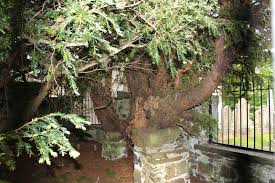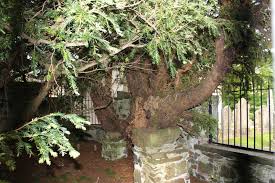
The oldest tree in Britain is reportedly changing its sex. Yes this is what botanists claim about the possible 5000 years old tree which is still alive and kicking.
This phenomenon of the tree has amazed botanists and scientists as well.
Identified as one of the oldest living things in Europe, Fortinall yew in Perthshire is justly famous. Since the most ancient and oldest parts of the tree have decayed and disappeared, no one can say for certain the actual age of the tree.
The 5000 year old tree has been identified to be male as the tree produces small spherical structures that release pollen which is not done by the female counterpart of this plant species. The female yews produce the more familiar bright red berries.
Three berries were spotted on a high branch of the tree, located in the churchyard of the village of Fortingall, Perthshire, by experts at the Royal Botanic Garden in Edinburgh. The berries were taken away for analysis as part of a conservation project.
Max Coleman of the Royal Botanic Garden, Edinburgh, found three red berries on the tree during a recent visit to the area and the tree.
The tree has survived the ravages of time and the attention of eager tourists, who in previous centuries took clippings from it as souvenirs. The tree is now protected by a small wall even as the trunk changed shape many years ago and has lost its center and one side.
“Odd as it may seem, yews, and many other conifers that have separate sexes, have been observed to switch sex. Normally, this switch occurs on part of the crown, rather than the entire tree changing sex. In the Fortingall yew, it seems that one small branch in the outer part of the crown has switched and now behaves as female” writes Coleman in his blog.
Tree experts say it is still extremely unusual even as there are reports that a botanist first noted a partial sex change on a yew in Shropshire in 1837.
Some species, such as holly or yew, are usually only male or female. However many tree species contain both male and female parts and they have inbuilt systems to stop it pollinating itself. Producing male flowers one year and female fruits another, a few species of trees such as ash, routinely switch sex. If a tree produces a large crop of seeds one year, it may switch the following year to male flowers to reduce the strain on itself.
However scientists and botanists are of the opinion that to protect themselves from disease, ancient trees can also create separate entities within their structure.
“It’s a strategy for longevity. The Fortingall yew is fragmented and it may be so compartmentalized that part of it has become sexually ambiguous. We are all continuously learning about ancient trees – the ageing process of trees is a new science” says Brian Muelaner, chair of the Ancient Tree Forum.
While during his visit Coleman picked the three berries, which have been sown in pots. Tree lovers and scientists will now wait with baited breath to see if the planted berries germinate next spring and if they do then the Fortingall yew will produce its first identifiable offspring in perhaps thousands of years.
(Source:www.theguardian.com)
This phenomenon of the tree has amazed botanists and scientists as well.
Identified as one of the oldest living things in Europe, Fortinall yew in Perthshire is justly famous. Since the most ancient and oldest parts of the tree have decayed and disappeared, no one can say for certain the actual age of the tree.
The 5000 year old tree has been identified to be male as the tree produces small spherical structures that release pollen which is not done by the female counterpart of this plant species. The female yews produce the more familiar bright red berries.
Three berries were spotted on a high branch of the tree, located in the churchyard of the village of Fortingall, Perthshire, by experts at the Royal Botanic Garden in Edinburgh. The berries were taken away for analysis as part of a conservation project.
Max Coleman of the Royal Botanic Garden, Edinburgh, found three red berries on the tree during a recent visit to the area and the tree.
The tree has survived the ravages of time and the attention of eager tourists, who in previous centuries took clippings from it as souvenirs. The tree is now protected by a small wall even as the trunk changed shape many years ago and has lost its center and one side.
“Odd as it may seem, yews, and many other conifers that have separate sexes, have been observed to switch sex. Normally, this switch occurs on part of the crown, rather than the entire tree changing sex. In the Fortingall yew, it seems that one small branch in the outer part of the crown has switched and now behaves as female” writes Coleman in his blog.
Tree experts say it is still extremely unusual even as there are reports that a botanist first noted a partial sex change on a yew in Shropshire in 1837.
Some species, such as holly or yew, are usually only male or female. However many tree species contain both male and female parts and they have inbuilt systems to stop it pollinating itself. Producing male flowers one year and female fruits another, a few species of trees such as ash, routinely switch sex. If a tree produces a large crop of seeds one year, it may switch the following year to male flowers to reduce the strain on itself.
However scientists and botanists are of the opinion that to protect themselves from disease, ancient trees can also create separate entities within their structure.
“It’s a strategy for longevity. The Fortingall yew is fragmented and it may be so compartmentalized that part of it has become sexually ambiguous. We are all continuously learning about ancient trees – the ageing process of trees is a new science” says Brian Muelaner, chair of the Ancient Tree Forum.
While during his visit Coleman picked the three berries, which have been sown in pots. Tree lovers and scientists will now wait with baited breath to see if the planted berries germinate next spring and if they do then the Fortingall yew will produce its first identifiable offspring in perhaps thousands of years.
(Source:www.theguardian.com)





